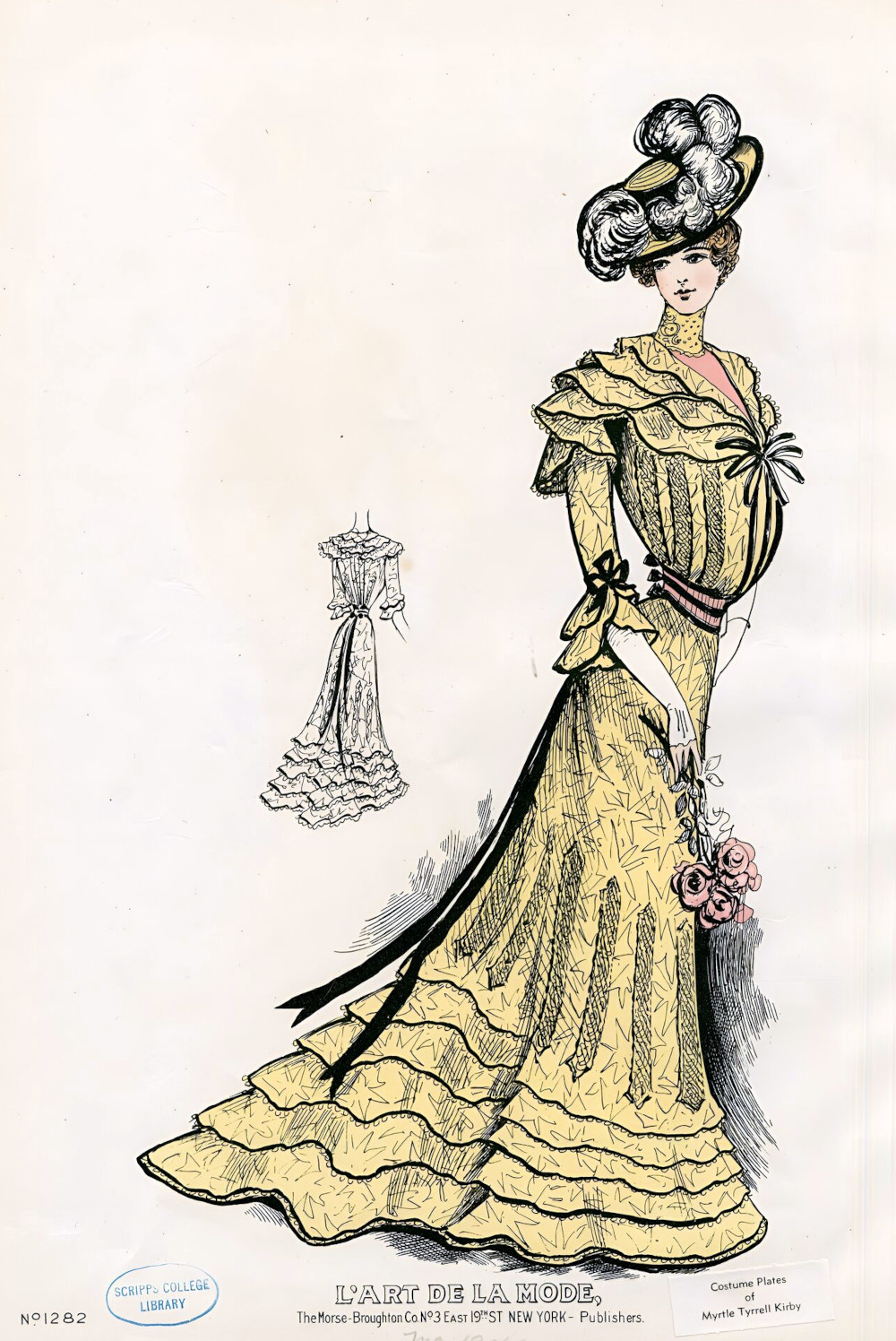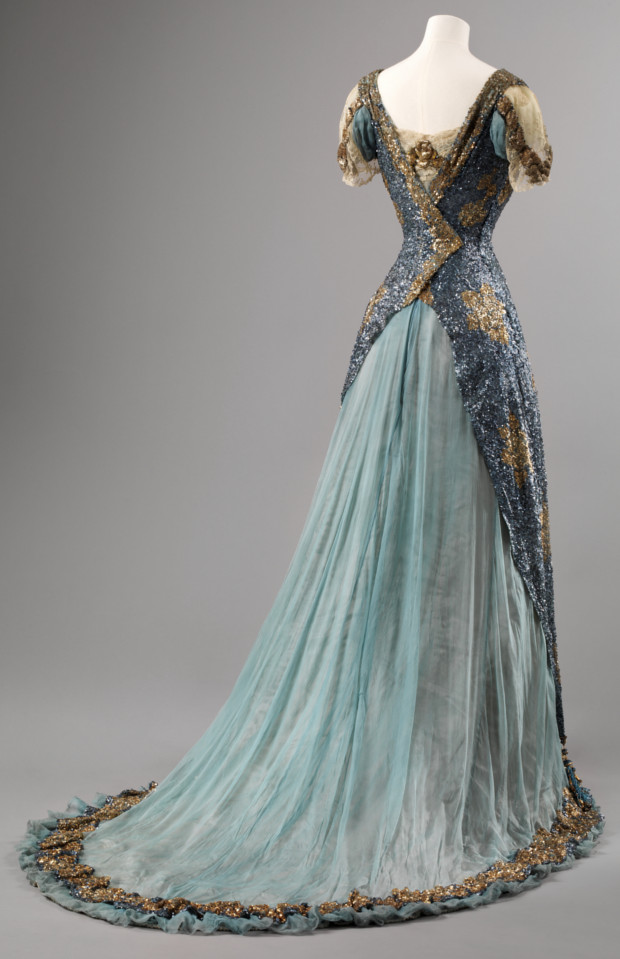The Edwardian era was the period covering the reign of King Edward VII, 1901 to 1910, and is sometimes extended to 1919.

Edward loved to travel, setting a style influenced by the art and fashions of Continental Europe.

“A leisurely time when women wore picture hats and did not vote, when the rich were not ashamed to live conspicuously, and the sun really never set on the British flag.” —Samuel Hynes.
Reminiscing in the 1920s, after the horrors of world war one, the Edwardian era was remembered with nostalgia.
A bygone time of long summer afternoons and garden parties, basking in a sun that never set on the British Empire.

Time for some Edwardian fashion fun.
Two French evening dresses from the Edwardian era (1901 – 1919) battle for your vote. Which one will win? Cast your vote to find out.
Dress A
c1905 Gala Dress. Silk tulle, machine woven silk in plain weave and satin. Silk ribbons, metal hooks. French, now owned by National Museum Norway.
Dress B
1909 evening gown with empire waist, short sleeves and fishtail hem; skirt is square sequins on net over satin fitted to fishtail. Callot Soeurs.

The Edwardian era marked a prominent turn in the direction of fashion for women.
Couturiers of Paris introduced a new columnar silhouette, with a distinctive “S” shaped curve.
It signaled the demise of the corset, which had been an indispensable garment of fashionable Victorian women.
The Edwardian era saw the full flowering of Parisian haute couture as the arbiter of styles and silhouettes for women of all classes.










A series of Edwardian fashion plates give us a good idea of the couturier designs that formed the basis for what women would wear.
Featuring Spring season designs from 1901 to 1906, these New York fashion plates also have notes from the designer.
The first plate features a rose red dress with a high collar and long sleeves. The dress has two decorative bands, one with horizontal stripes of deep pink and black, and the other with pink floral brocade. The collar and bodice have a “v” design, and the sleeves include puffed sections of rose. The skirt is gathered to the waist, flaring out with a slight train at the back. Decorative bands create a petal effect above the hem.










The second plate features the dark, up-swept “Gibson Girl” hairstyle and long red dress with a black trellis-like diamond pattern on the bodice and skirt. The outfit starts with a high-necked, long-sleeved floral blouse in white, red, and black. The blouse extends beneath a full bodice, cinched at the waist with several black bands. The dress flows to the ground with a double layer of red ruffles and a train of tightly-gathered folds at the back, ending in ruffles. The rear view of the dress is shown in black and white.










The third plate features a yellow gown with leaf or abstract flower pattern, deep V-neck over a pink under-layer, and high lace collar. The collar has three or four picot-edged ruffles with narrow black bands and a rosette of eight loops of narrow black ribbon at the V-neck. Bodice features three vertical bands of black lace on each side of the center front.
Elbow-length sleeves mirror the collar with ruffles and a black rosette. The waist has three horizontal rows of black with bows at the back, and two long streamers over the gored skirt, flaring into a trumpet hem with a slight train. Vertical lines of black lace surround the skirt at knee length, and five bands of ruffles with picot-edged black ribbon adorn the hem.
Complete with elbow-length mitts and a black-banded, yellow flat-brimmed straw hat with white ostrich plumes.










The fourth plate features a home outfit with an elaborate up-swept hairstyle, rose-colored gown with floral-patterned sleeves, lower bodice, and skirt insets. Square neckline with pleats for fullness, floral lower bodice with rose cap sleeves, and bands of trim. Lower floral sleeves are full to the elbow, gathered snug from elbow to wrist. Softly gathered skirt flares into a trumpet hemline, flat at the front with three bands of decorative stitching on the hips. Ornate floral bands decorate the skirt below the knee on each side.










Of course, it just wouldn’t be the Edwardian era without hats, would it? Nine photographs of women numbered 1 through 9 show a variety of hats for Spring 1902.
In the upper left, number 1 wears a dark dress with a white jabot and a hat adorned with overlapping rows of leaves.
Below her, number 2 dons a high-necked white lace dress with a dark straw flat-brimmed hat featuring white on the crown and roses under the left side.
Number 3 sports a dark jacket over a white lace high-necked blouse. Her hat is woven straw with wide strands and several large feathers on the crown.
In the center column at the top, number 4 wears a white lace dress similar to number 2, with a hat covered in white lace, bows, and roses.
Number 5 wears a white lace gown with a jabot, and her hat has an upstanding brim adorned with rows of small beads and feathers fastened by a round jeweled brooch.


Number 6 is in a black outfit trimmed with white-edged ribbons, checks, and lace. Her dark hat has a high brim trimmed with white lace and adorned with many white plumes.
At the top of the right-hand column, number 7 wears a dark patterned high-necked blouse with a deep white collar featuring a scalloped hem and inset diamond patterns.
Number 8 wears the same dress as number 6. Her small-brimmed white hat is adorned with white flowers, bows, and black-dotted veiling.
Number 9, with her back turned, wears a light jacket with a fluffy white jabot. Her white hat has a banded brim turned up, trimmed with ruched dark velvet ribbon around the crown, and a jaunty feather at the side.








Edwardians showcased their latest fashions at horse races, as seen in the next plate featuring three women in conversation amidst an attentive crowd.


On the left, a woman wears a mulberry embroidered French voile gown with a high lace collar, softly gathered sleeves, and a flared skirt. Her high-crowned straw hat is adorned with purple flowers and a large black feather plume.
In the center, a woman dons a black chiffon satin taffeta gown with a high white lace collar extending to the waist. Top-stitched pleats at the shoulders create bust fullness, and the skirt features inverted box pleats. Her black velvet hat has a turned-up brim and is decorated with a large white ostrich plume.
On the right, a woman wears a pale yellow tussar gown with Irish lace, featuring a v-neck collar, released pleats, and elbow-length sleeves with lace cuffs. A soft bow tie and a fabric belt with a large buckle accentuate the waist. Her wide-brimmed straw hat, adorned with a black band and a large yellow rose, complements the ensemble.
References: Wikipedia, Clairemont College, National Museum of Norway, Gregg Museum of Art & Design.




